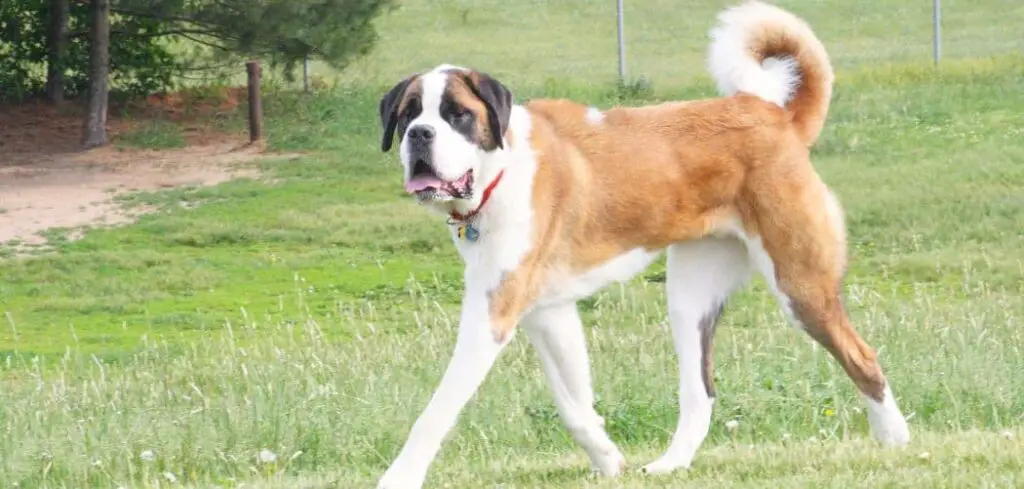One of the most common health issues a Saint Bernard can have is weight problems. Gaining or losing weight too fast are the major concerns.
So, is your Saint Bernard too skinny? Is it normal or should you be concerned?
In this article, we will aim to show you how to tell whether your Saint Bernard is underweight, what causes them to be skinny and how to keep them healthy.
Table of Contents
Is My Saint Bernard Too Skinny?
Your Saint Bernard is not too skinny if they are between 120 and 180 pounds as an adult dog. Some dogs may not fit exactly into this weight range because of different growth rates, but still be healthy. If a Saint Bernard’s body looks thin, with their bones showing and easy to feel, they are too skinny.

Is it normal for Saint Bernards to look skinny?
It is normal for Saint Bernards to look skinny if there are no underlying medical causes and the dog is feeding well because different dogs grow at different rates and some will have a weight that is below the average estimates for their age.
Regular health checkups by the veterinarian should be done to rule out any health problems and recommendations provided towards healthy weight gain and development based on their age.
How much do Saint Bernards weigh?
The weight of a Saint Bernard depends on their age and their development stage. An adult male Saint Bernard’s weight ranges between 140 and 180 pounds while female dogs weigh between 120 to 140 pounds.
The adult St. Bernard size or height for the male is 28 – 30 inches at the shoulder while the female is 26 – 28 inches.
The female Saint Bernard’s weight and height are slightly below the male dog’s measurements.
The St. Bernard growth chart below shows the average weight they should be at a certain age which gives an overall picture of what is to be expected.
Remember all dogs grow at different rates therefore it is also quite normal for a dog to weigh below or above the average range. The most important aspect is to have regular weight checks with your veterinarian to monitor and ensure your dog or puppy is healthy and not too skinny.
Below is the average estimate of a Saint Bernard’s height and weight at different ages:
Age | Male Weight | Female Weight |
1 month | 10 – 25 lbs | 10 – 20 lbs |
2 months | 25 – 40 lbs | 15 – 35 lbs |
3 months | 40 – 55 lbs | 35 – 50 lbs |
4 months | 50 – 65 lbs | 45 – 65 lbs |
5 months | 65 – 80 lbs | 55 – 80 lbs |
6 months | 80 – 100 lbs | 65 – 90 lbs |
7 months | 90 – 110 lbs | 75 – 100 lbs |
8 months | 100 – 120 lbs | 85 – 110 lbs |
9 months | 105 – 125 lbs | 90 – 115 lbs |
10 months | 115 – 135 lbs | 90 – 115 lbs |
11 months | 125 – 150 lbs | 100 – 120 lbs |
1 year | 130 – 165 lbs | 110 – 130 lbs |
2 years | 140 – 180 lbs | 120 – 140 lbs |
How do I know if my Saint Bernard is underweight?
At-home tests can give you an idea of what to look for to determine if your Saint Bernard is underweight. These are the basic first steps before you consult your veterinarian so that they can conduct a complete examination and run further tests.
Only a veterinarian can determine for certain if there is something medically wrong with your dog.
It may be difficult to put your dog on a scale to weigh them, so instead, first, rub your hand along your dog’s sides and feel how pronounced their ribs are. You should be able to feel their ribs with light pressure applied.
If it seems like you can feel a lot of their ribs with light pressure your dog could be underweight.
Also, run your hand along your dog’s spine and feel how the vertebrae are pronounced. If you can easily feel the backbone, that’s also a possible sign they are underweight.
Next, look down at your St. Bernard from behind them. You should see their waist curving from the rib cage towards the waist. If they are underweight, the inward curve will be sharp and small.
The St. Bernard has thick fur so this can prevent you from gauging this body frame, therefore feel their body as a gauge.
Another way to examine your dog is to look at them from the side, observing their abdomen. If they have a healthy weight, their stomach goes upward from the rib cage.
A Saint Bernard that is too skinny will have an abdomen or stomach that appears to be sharply tucked upward from the ribs.
Therefore, a Saint Bernard is too skinny when there are prominently protruding bones such as ribs, hips, and spine as well as the appearance of a sunken abdomen within the rib cage.
What do I do if my Saint Bernard feels and looks too skinny?
If you suspect that your St. Bernard is underweight, consult your veterinarian.
Even if your dog’s behavior and appetite appear completely normal, unexplained weight loss or lack of weight gain should always be addressed by your veterinarian.
What To Avoid Doing
Overfeeding
It can be tempting to add more cups of food to each serving for their dog to encourage weight gain but don’t overfeed them. This is detrimental to a Saint Bernard’s growth and should be avoided.
Overfeeding a St. Bernard over the recommended amount will make them overweight which causes a strain on their skeleton and joints. This leads to abnormal orthopedic development.
Always feed them the recommended amount based on their age and as per the breed’s diet requirements or as directed by your veterinarian.
Adding extra nutritional supplements
Another temptation is to add extra nutritional supplements to encourage weight gain and growth. Do not do this. Supplements only promote a dog’s health and cannot help your Saint Bernard put on weight.
Excessive supplements can be harmful to your dog. For example, excess vitamin D intake leads to toxicity while excess calcium leads to the development of orthopedic diseases.
Always consult with a veterinarian on the appropriate quantities for your dog.
What causes a Saint Bernard to be underweight?
A St. Bernard can be underweight due to weight loss or inadequate weight gain due to various contributing factors, which results in being below the average weight at a certain age. These factors include:
A Poor diet
A poor diet with insufficient calories and nutrients that does not support a Saint Bernard’s nutritional and energy level requirements leads to poor development and weight gain.
A St. Bernard needs high-quality food specifically formulated for the breed to provide the essential nutrition for healthy weight gain.
St. Bernard puppies have growth spurts in the first year of growth and require an appropriate diet during this time to support proper development. If not provided, they can become skinny and also face developmental problems.
Underlying diseases
The presence of underlying diseases can cause a lack of weight gain and weight loss.
Diseases such as diabetes, inflammatory bowel disease, digestive issues, stress, hyperglycemia, or intestinal parasites especially hookworms and roundworms, all cause this.
Certain conditions and illnesses also cause malabsorption which is the difficulty of nutrient absorption from food, which prevents weight gain and leads to weight loss.
Related: Saint Bernard With Diarrhea: When it’s serious and how to stop it
Dental problem
A painful dental problem such as dental disease is very uncomfortable for a Saint Bernard.
This can result in loss of appetite which makes your dog not eat as much food or not at all, which also affects their weight gain.
Insufficient amount of food
An insufficient amount of food can also contribute to an underweight Saint Bernard.
Saint Bernards need to be fed high-quality meals in the right amounts based on their age. If the food amounts are insufficient this limits healthy weight gain.
Competition at the food bowl
Competition for food that is served together with other dogs in a home can also limit the weight gain of a Saint Bernard.
Your dog could be eating small portions because of sharing and struggling to eat with the other dogs. Therefore a Saint Bernard ends up not having enough and may not gain or lose weight as expected because of not feeding properly.
The solution to this is to feed your Saint Bernard separately to enable them to get their daily required portions.
This will reduce the stress of having to struggle to get enough food during meal times. Eating appropriate serving portions helps with healthy weight gain for a puppy.
What should I feed my Saint Bernard to gain weight?
If your dog is a little below the average weight of a Saint Bernard at their age, talk to your veterinarian first. The veterinarian will examine them and be able to identify or rule out any medical problems and recommend the best diet for your dog.
Therefore with your veterinarian’s guidance, you will have your dog’s specific nutritional requirements and diet.
A St. Bernard’s food should have key nutrients to provide balanced nutrition for proper growth. The food should be well-balanced to prevent rapid weight gain which can be detrimental to their health.
The key nutrients include:
- Quality protein source for muscle development.
- Carbohydrates and fats provide calories that are used as energy.
- Essential vitamins and minerals which support their health.
- Probiotics for promotion of digestive health of a Saint Bernard.
Takeaway
A skinny Saint Bernard can be a cause for alarm, especially for a breed that is expected to grow massively.
Some underlying causes can lead to this but usually, this is normal because dogs grow at different rates and can fall below the average weight estimates for their age.
Regular medical exams and checkups are important to monitor growth and healthy weight gain as well as identification of any health problems that can cause weight loss gain or a lack of weight gain.
With verification from your veterinarian, you can be well assured that your Saint Bernard is doing well even if they are slightly skinny.
